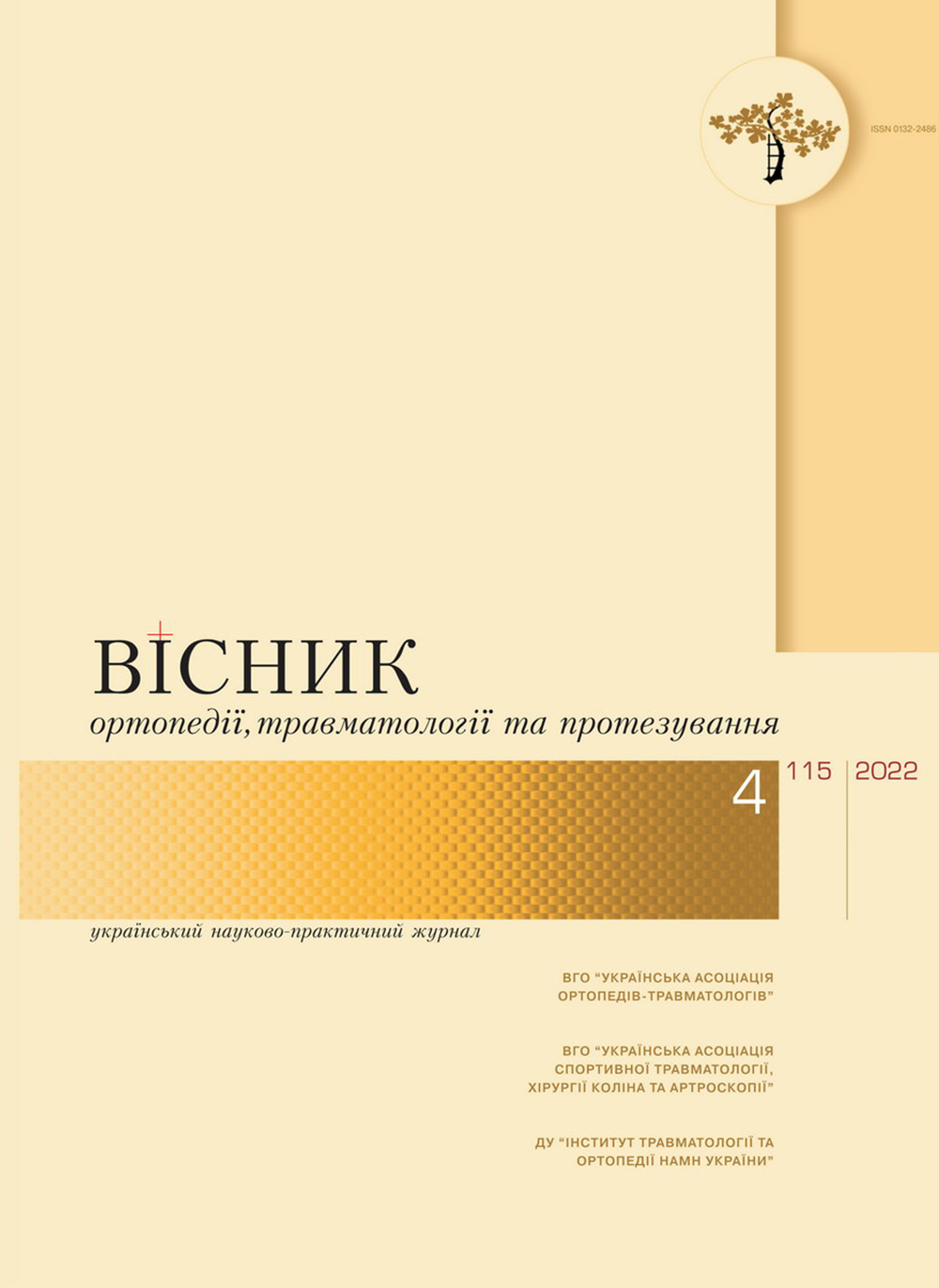Abstract
Summary. The flatfoot remains a poorly defined clinical entity.
Objective: to study the movements that occur in the foot under a single-support load on a two-segment model of the normal foot and flatfoot under different mechanical properties of the capsular-ligamentous complex acetabulum pedis.
Materials and Methods. A two-segment model of the foot was developed, which consisted of anatomical hindfoot and forefoot. The connection between them was represented by a complex consisting of lig. calcaneonaviculare and the tendon of m. tibialis posterior. A decrease in the mechanical strength of the complex was represented by three types of tendon tissue degeneration according to Z.S. Rosenberg et al.: 0% – the norm, 25% – type І, 50% – type ІІ, and 75% – type ІІІ. The 3D finite element model was created using real foot skeletons from 12 patients with acquired flatfoot, obtained from 3D reconstructions with CT. The model was loaded with a force of 750 N from the plateau of the tibia in the direction of the ground surface. The adequacy of the model was assessed by examining the dependence of the simulation results with the values of the talo-navicular uncovered angle of the same patients.
Results. The mutual movement of the segments forming the foot model progressively increased with a decrease in the strength of the capsular-ligamentous complex from 4.18 mm in the norm to 8.36 mm in type III degenerative changes. The linear nature of the dependence of total displacements on the decrease in the mechanical strength of the capsular-ligamentous complex is confirmed by the assessment of the adequacy of the model.
Conclusions. The decrease in the mechanical strength of the capsular-ligamentous complex acetabulum pedis under a single-bearing load causes the mutual movement of segments of the model twice as large compared to the norm; the calculated dependence of movement/decrease in strength is linear.
References
Mosca VS. Flexible flatfoot in children and adolescents. J Child Orthop. J Child Orthop. 2010;4(2):107-21. DOI: 10.1007/s11832- 010-0239-9.
Stewart SF. Human gait and the human foot: an ethnological study of flatfoot. І. Clin Orthop Relat Res. 1970;70:111-23. PMID: 5445716.
Banwell HA, Paris ME, Mackintosh S, Williams CM. Paediatric flexible flat foot: how are we measuring it and are we getting it right? A systematic review. J Foot Ankle Res. 2018;11:21. DOI: 10.1186/s13047-018-0264-3. eCollection 2018.
Meary R. Le pied creux essentiel, 19i me r union annuelle de la SOFCOT. Rev Chir Orthop Repar Appar Mot. 1967;53(3):389-467.
Seringe R, Wicart P, French Society of Pediatric Orthopaedics. The talonavicular and subtalar joints: the “calcaneopedal unit” concept. Orthop Traumatol Surg Res. 2013;99(6 Suppl):S345-55. DOI: 10.1016/j.otsr.2013.07.003.
Rosenberg ZS, Cheung Y, Jahss MH, Noto AM, Norman A, Leeds NE. Rupture of posterior tibial tendon: CT and MR imaging with surgical correlation. Radiology. 1988;169(1):229-35. DOI: 10.1148/ radiology.169.1.3420263.
Xu J, Abdullah A, Alkhatib N, Huang Y, Xie D, Deng Z. Isolated medial column stabilization surgery does not benefit adult acquired flatfoot stage IIa nor IIb by three-dimensional finite element biomechanical analysis. Am J Transl Res. 2021;13(11):12834 – 42. eCollection 2021. PMID: 34956498.
Merian M, Kaim A. The plantar fascia talar head correlation: a radiographic parameter with a distinct threshold to validate flatfoot deformity and its corrective surgery on conventional weightbearing radiographs. Foot Ankle Int. 2022;43(3):414- 425. DOI: 0.1177/10711007211052258.
Ghanem I, Massaad A, Assi A, Rizkallah M, Bizdikian AJ, El Abiad R et al. Understanding the foot’s functional anatomy in physiological and pathological conditions: the calcaneopedal unit concept. J Child Orthop. 2019;13(2):134-146. DOI: 10.1302/1863-2548.13.180022.
Close JR, Inman VT, Poor PM, Todd FN. The function of the subtalar joint. Clin. Orthop. Relat. Res. – 1967. – V.50, N.1. – P.159 – 179. PMID: 6029014.
Deschamps K., Staes F., Roosen P. Nobels F, Desloovere K, Bruyninckx H, Matricali GA. Body of evidence supporting the clinical use of 3D multisegment foot models: a systematic review. Gait Posture. 2011;33(3):338-49. DOI: 10.1016/j.gaitpost.2010.12.018.
MacConnail M.A., Basmajian J.V. Muscles and movements. A base for human kinesiology. Baltimore: Williams & Wilkins, 1969.
Davis RB III, Õunpuu S, Tyburski D, Gage JR. A gait analysis data collection and reduction technique. Hum. Mov. Sci. – 1991. – V.10, N.4. – P.575 – 587.
Carson MC, Harrington ME, Thompson N, O’Connor JJ, Theologis TN. Kinematic analysis of a multi-segment foot model for research and clinical applications: a repeatability analysis. J Biomech. 2001;34(10):1299-307. DOI: 10.1016/s0021- 9290(01)00101-4.
Kidder SM, Abuzzahab FS Jr, Harris GF, Johnson JE. A system for the analysis of foot and ankle kinematics during gait. IEEE Trans Rehabil Eng. 1996;4(1):25-32. DOI: 10.1109/86.486054.
Leardini A, Benedetti MG, Berti L, Bettinelli D, Nativo R, Giannini S. Rear-foot, mid-foot and fore-foot motion during the stance phase of gait. Gait Posture. 2007;25(3):453-62. DOI: 10.1016/j. gaitpost.2006.05.017.
Rankine L, Long J, Canseco K, Harris GF. Multisegmental foot modeling: a review. Crit Rev Biomed Eng. 2008;36(2-3):127-81. DOI: 10.1615/critrevbiomedeng.v36.i2-3.30.
Spratley EM, Matheis EA, Hayes CW, Adelaar RS, Wayne JS. Validation of a population of patient-specific adult acquired flatfoot deformity models. J Orthop Res. 2013;31(12):1861-8. DOI: 10.1002/jor.22471.
Abousayed MM, Tartaglione JP, Rosenbaum AJ, Dipreta JA. Classifications in brief: Johnson and Strom classification of adult- acquired flatfoot deformity. Clin Orthop Relat Res. 2016;474(2):588- 93. DOI: 10.1007/s11999-015-4581-6.
Filardi V. Finite element analysis of the foot: Stress and displacement shielding. J Orthop. 2018;15(4):974-979. DOI: 10.1016/j.jor.2018.08.037.
Wang C, He X, Zhang Z, Lai C, Li X, Zhou Z, Ruan K. Three- dimensional finite element analysis and biomechanical analysis of midfoot von mises stress levels in flatfoot, clubfoot, and Lisfranc joint injury. Med Sci Monit. 2021;27:e931969. DOI: 10.12659/ MSM.931969.

This work is licensed under a Creative Commons Attribution 4.0 International License.
